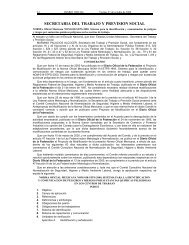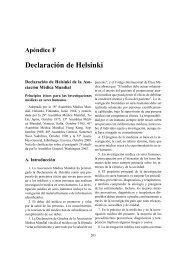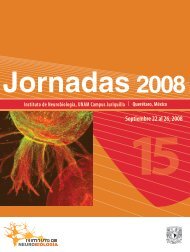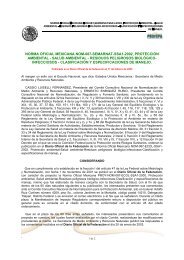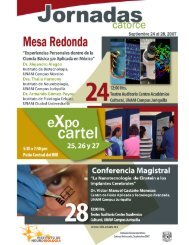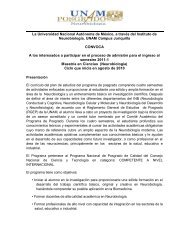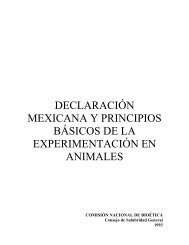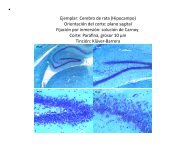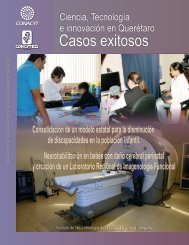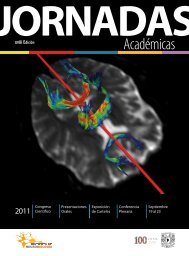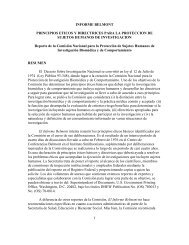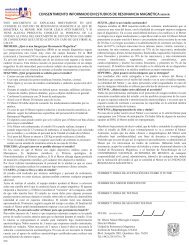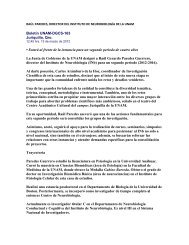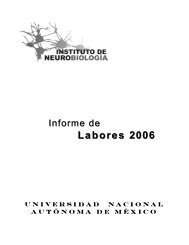Hormonas Tiroideas y Cerebro. Notas Sobre La Relación Bocio y ...
Hormonas Tiroideas y Cerebro. Notas Sobre La Relación Bocio y ...
Hormonas Tiroideas y Cerebro. Notas Sobre La Relación Bocio y ...
You also want an ePaper? Increase the reach of your titles
YUMPU automatically turns print PDFs into web optimized ePapers that Google loves.
composition of this enzyme system are recent (5, 6). Among the two recently cloned NADPH<br />
oxidases, THOX1 and THOX2 (also referred to as DUOX1 and DUOX2), THOX2 is essential for<br />
thyroidal H 2 O 2 generation. Structurally, these proteins contain seven putative transmembrane<br />
domains, four NADPH binding sites, one FAD binding site, and in line with the predicted regulation by<br />
calcium an EF (everted finger) motif (5, 6).<br />
Heterozygous loss of function mutations in the THOX2 gene result in mild transient congenital<br />
hypothyroidism (22). Biallelic THOX2 mutations are associated with a severe phenotype and confirm<br />
that H 2 O 2 is essential for iodide organification (22).<br />
THOX2 (DUOX2) requires a maturation factor, DUOXA2, an ER-resident transmembrane<br />
protein, in order to translocate to the cell membrane (23). Mutations in DUOX2 result in impaired<br />
trafficking to the cell membrane (24).<br />
Thyroglobulin<br />
Thyroglobulin (TG) is produced by thyroid follicular cells and secreted into the follicular lumen<br />
(7). Some of its tyrosine residues are iodinated by TPO (organification/iodination), and the tyrosines<br />
MIT and DIT are subsequently coupled to form T3 and T4 (coupling). TG is therefore considered to be<br />
a thyroid hormone precursor. Besides its importance for hormone synthesis, TG allows storage of<br />
iodine and thyroid hormone and thus to adapt to scarce iodine supply.<br />
The human TG gene is very large, spans about 270 kb and contains 48 exons. The<br />
transcription of the TG gene is controlled by transcription factors such as TTF-1 (NKX2.1), TTF-2<br />
(FOXE1) and PAX 8. The TG protein monomer is composed of a 19-amino acid signal peptide<br />
followed by 2749 residues containing 66 tyrosines. TG contains an average number of tyrosine<br />
residues, altogether 67, but only a minority of these residues localized in the carboxy- and<br />
aminoterminus are hormonogenic sites. Complete hydrolysis of iodinated TG yields only 2 to 4<br />
molecules of the iodothyroxines T4 and T3. The mature protein is formed by two units in noncovalent<br />
linkage (19 S TG). 10 % of the total weight is formed by carbohydrates and glycosylation plays an<br />
important role in the structure of the protein. The primary structure of the TG protein contains three<br />
regions with repetitive sequences with internal homology and the carboxy-terminal part shares<br />
remarkable homology with acetylcholinesterase. This structure suggests the possibility of a<br />
convergent origin of the TG gene from two different ancestral DNA sequences (7).<br />
Defects of TG synthesis or secretion have been studied in several animal strains and human<br />
patients (25). TG gene defects are inherited in an autosomal recessive manner. The phenotype is<br />
typically characterized by goitrous enlargement of the thyroid. The metabolic status is variable and,<br />
depending on the severity of the defect, the patients are hypothyroid, subclinically hypothyroid, or<br />
euthyroid. Unless treated with levothyroxine, goiters are often remarkably large and display continuous<br />
growth. Symptoms caused by compression of adjacent neck structures can occur. The radioiodine<br />
uptake is elevated indicating an activation of the iodine concentration mechanism, due to chronic<br />
stimulation of TSH. In patients evaluated with a perchlorate discharge test, there is no increased<br />
release of radioiodine after administration of the competitor, indicating that the organification process<br />
itself is not affected. The serum TG levels can vary from low to low normal, and the presence of an<br />
abnormal TG level in a goitrous individual is suggestive for defective TG synthesis. An abnormal TG<br />
synthesis may also be suggested by the presence of abnormal iodoproteins in the serum. Since there<br />
is no normal intrathyroidal TG, albumin as well as other proteins are iodinated, generating<br />
iodotyrosines and iodohistidines.<br />
Molecular analysis of several TG point mutations found in patients with congenital<br />
hypothyroidism and in the cog/cog mouse, which all present with goiters, reveal that at least some of<br />
these alterations result in a secretory defect and thus an endoplasmic reticulum storage disease<br />
(ERSD) (26, 27).<br />
10



